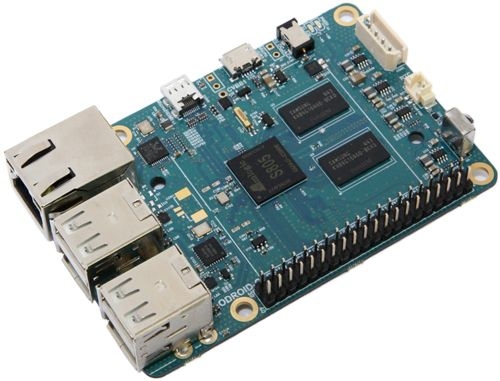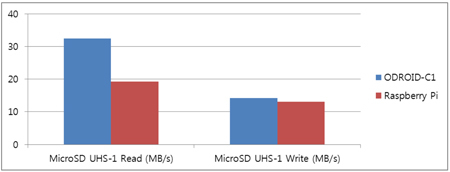ODROID-C1 - review and comparison with RPi

Good day, dear habrovchane and just random guests.
In this post, I made a small review of the new ODROID-C1 mini-computer versus the Raspberry Pi when using both devices as a set-top box / media server for home. The article is designed for connoisseurs of Raspberry Pi or other similar platforms.
Raspberry pi
A few words about RPi, which I have been using for over a year as a home media center / TV set-top box.
The media server operation is provided by the linux assembly of OpenELEC - one of the most popular media centers out of the box for decoding.
Tasks that the device performs for me personally:
- watch IPTV
- watching movies from a local network (from a PC) and from a USB HDD
- playing music
- view photo
- control of the device through the remote control of the TV (HDMI CEC) or your own.
The achilles heel of this solution is insufficient performance to watch Full HD IPTV channels that are gaining popularity (Travel HD, Discovery, local channels). After 5-10 seconds, this channel starts to slow down, the picture crumbles, and then disappears altogether. Also, the Kodi interface (formerly XBMC) slows down noticeably.
In this regard, I periodically look at competitive platforms. Solutions like TV boxes are not very attractive for various reasons.
ODROID-C1
In December 2014, South Korean company HardKernel introduced its new platform ODROID-C1, which is close to RPi in price, form factor and functionality. Computer cost $ 35 as RPi. Power is several times higher. Without hesitation, I purchased this device and already, I will tell you a secret, replaced the home RPi with C1. True, without pitfalls and a ladle of tar was not done, but could not resist such an increase in productivity. From my point of view, the device is still quite raw in terms of software, but is already able to compete.
')


Comparison
I chose ODROID-C1 to replace RPi, because its price niche is the same - $ 35, the form factor is the same, passive cooling, but the power is much higher - about 2-4 times, and according to the tests given below ...
Also pleases a large assortment of peripherals / accessories for the ODROID line. For example: camera, wi-fi module, screen, dev-console and so on. All that is necessary can be ordered immediately in one package.
Table 1. Comparison of RPi and ODROID-C1.
| Parameter | RPi B + | C1 |
|---|---|---|
| release date | July 2014 | December 2014 |
| CPU | BCM2835 700MHz ARMv6 40nm Single Core ARM1176JZ-F Applications Processor | Amlogic S805 1.5GHz ARMv7 28nm Quad Core Cortex ™ -A5 |
| Video processor | Dual Core VideoCore IV® 250MHz 1080p H.264 decode / encode OpenGL, ES 1.1 / 2.0 | Quad Core Mali-450 600MHz 1080p H.264 decode / encode H.265 decode OpenGL, ES 1.1 / 2.0 |
| Memory | 512MB DDR2 400MHz | 1GB DDR3 792MHz |
| External memory (connectors) | micro SD | microSD eMMC |
| USB ports | 4 x USB 2.0 micro USB | 4 x USB 2.0 micro USB USB OTG |
| Camera port | MIPI CSI 1080p | USB 720p |
| Ethernet | 10/100 | 10/100/1000 |
| GPIO | 40pin port (GPIO / UART / SPI / I2C / I2S) | 40pin port (GPIO / UART / SPI / I2C / ADC) |
| IR port | no (you can connect the sensor via GPIO) | there is on board |
| ADC | not | 10bit SAR 2 channel |
| Soft | a lot (OpenELEC, RaspBMC and others) | Ubuntu 14.04 LTS, Android KitKat |
| Price | $ 35 | $ 35 |
| Virtues | - there is an audio output - there is a composite video output - stable proven platform with a large community - a lot of ready-made software disk images (OpenELEC, RaspBMC etc) | - more powerful processor - more memory - H265 decoding - 1Gbit ethernet - eMMC slot - IR receiver on board - many accessories / peripherals on the off site - promising |
| disadvantages | - not enough processor power | - micro HDMI cable is more expensive than HDMI - there are no drivers for HDMI CEC yet - there are problems with the software (drivers) - few software images (only official builds) |
This table covers the comparison of devices in the context of the media center. Undoubtedly, in another application, RPi would be preferable to C1.
Testing both platforms with Unix-Bench
shows that C1 is 6 times faster.

I / O operations

Real test dd if / of
dd if = / dev / zero of = / dev / null & pid = $!
kill -USR1 $ pid; sleep 1; kill $ pid
8395845 + 0 records in
8395845 + 0 records out
4298672640 bytes (4.3 GB) copied, 17.3226 s, 248 MB / s
I will sum up. Undoubtedly, ODROID-C1 is still quite raw product and has its drawbacks. Currently, HDMI CEC does not work in ubuntu stock images, there are problems with some micro SD cards. But as a media center, the device is already quite ready to replace the RPi, which I did. The speed of work is significantly higher - 2-4 times. Channel switching occurs in 2-3 seconds, buffering is much faster, Kodi interface itself is faster, EPG update is much faster.
Setting up a Kodi media center
If you decide to use C1 as a media server, you will need to work a little with your hands, for example, to set up the remote control. Also a couple of tips on choosing an SD card, build software.
First you should choose a micro SD card. SanDisk 10 class UHS-I is best suited for this. My device works on the map
Transcend 16GB class 10 UHS-I. There are download problems with some cards.
The next step is downloading the image of Ubuntu 14.04 from the official site.
We write the image on the SD card and run the device.
In the stock build Ubuntu already installed Kodi, so that we can immediately begin to view records, music and photos.
To connect the remote control, you will need a small hand to set the correspondence of the remote control buttons to the codes of the keyboard buttons in Linux.
http://forum.odroid.com/viewtopic.php?f=112&t=8062&p=62862&hilit=ir+remote#p62599
If you have IPTV, and almost every Internet operator provides it, then you will need to build a PVR addon for Kodi.
Download addon sources here: https://github.com/opdenkamp/xbmc-pvr-addons . Build should not be a problem. Steps are described in github.
If you have questions - read the official forum forum.odroid.com, there is a lot of information.
All the best!
Source: https://habr.com/ru/post/247337/
All Articles